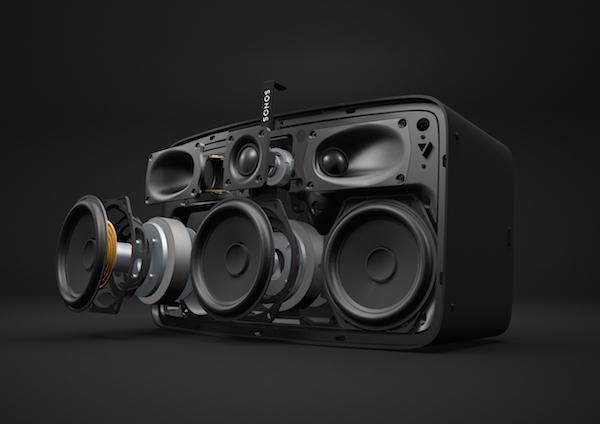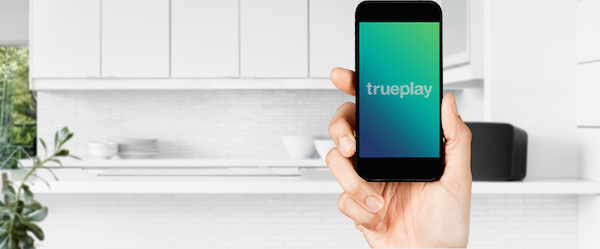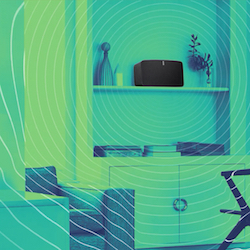New Sonos Trueplay Tuning Tech and PLAY:5 Are Stunning

In other words, it won’t be long before all streaming music systems will be referred to as a “Sonos system”—as in, “I’m looking to buy a Sonos system for my house. Should I get a HEOS Sonos system, a Bluesound Sonos system, or a Sonos Sonos system?”
I’m not simply regurgitating some hyped-up Sonos press release, either. The new Sonos stuff that’s coming is that good.
Early last week, Sonos invited some of the top tech press people from around the world to their laid-back, bring-your-dog-to-work headquarters in Santa Barbara, California. (I was there only because Rob couldn’t find anyone else to go in his place.) Aside from giving us all an in-depth look into the company, its processes, and the top-notch folks working there, Sonos gave us a chance to learn what Trueplay is and experience how it works.

Trueplay Tuning to the Rescue
In a nutshell, Trueplay is a room acoustics tuning technology. Thought of that way, there’s nothing to get overly orgasmic (or even slightly aroused) about. There are plenty of products with room tuning capabilities, and some are better than others. The results of using Trueplay, however, are stunningly, spectacularly, amazingly, unbelievably incredible. (I’d have gone on, but I ran out of superlatives.)
 Here’s how Trueplay works. From the Sonos app on your iOS device, you initiate the Trueplay calibration routine. An in-app video walks you through the process the first time you attempt it. As your PLAY-series speaker (PLAY:1, PLAY:3, PLAY:5) emits a series of test tones, you walk around the room waving the microphone end of your iPhone or iPad up and down while you walk around the perimeter of your room. Combined with the alien-sounding test tones, it feels like you’re performing an acoustics-demon exorcism as you bless the room with your iPhone.
Here’s how Trueplay works. From the Sonos app on your iOS device, you initiate the Trueplay calibration routine. An in-app video walks you through the process the first time you attempt it. As your PLAY-series speaker (PLAY:1, PLAY:3, PLAY:5) emits a series of test tones, you walk around the room waving the microphone end of your iPhone or iPad up and down while you walk around the perimeter of your room. Combined with the alien-sounding test tones, it feels like you’re performing an acoustics-demon exorcism as you bless the room with your iPhone.
After a brief bit of number crunching, your PLAY speaker (single or pair) is calibrated and ready to play. Even if you didn’t quite get the exorcism vibe during the acoustic blessing of the room, you’ll still feel like a miracle just happened when you start playing music.
Yes, it’s that good.
The mind-blowing moment came when the folks at Sonos demonstrated the effects of Trueplay on a pair of PLAY:1 speakers in the kitchen/break room they had set up for their staff. One speaker was placed along the side of the microwave oven up close to the back wall. The other speaker was—well, that’s what they wanted us to discover based on what we heard. The pair of PLAY:1s had already been Trueplay-ed, so we could hear the demonstration both with and without the processing turned on.
Without Trueplay, the speakers sounded—as you would expect—something akin to the world’s largest whoopee cushion…
...with the majority of the unimpressive sound coming from the speaker by the microwave.
With Trueplay, the combo not only sounded awesome, it also sounded like a pair of speakers, with the sound evenly distributed across the front of the room. It was totally mind-blowing that a speaker set off to the side on a kitchen counter could sound so good. When asked where the other speaker was located, most of us pointed to the cabinets hanging on the wall to our right—and, although I can’t speak for everyone there, pretty much all of us suspected the speaker was sitting on top of the cabinet just out of sight.
We were wrong.
The right-side PLAY:1 speaker wasn’t on top of the cabinet. The PLAY:1 was inside the cabinet. Behind a wooden door. And it sounded great with the door closed.
With the cabinet door open so we could see the speaker, it sounded like…well, let’s just say it sounded awful. Which makes sense, of course, since the Trueplay calibration was done to correct for the effects of the wooden door being closed.
Sonos hasn’t yet said when Trueplay will be available other than “coming this fall.” All I can say about that is, “Don’t toy with me, Sonos. I want Trueplay. I want it. I want it. I want it.”
If you already own any Sonos PLAY-series speakers, you might be thinking that Trueplay is great and awesome and good and all, but you’re not in the market for a new speaker system. You like your current Sonos speakers just fine, thank you. Well, I’ve got some more exciting Trueplay news for you. When it becomes available, Trueplay will be backwards compatible with all of Sonos’s existing PLAY speakers courtesy of a free firmware update. Yes, you read that correctly. It’s going to be included in a FREE firmware update. In other words, if you bought an original PLAY:5 when it first came out five-and-a-half years ago, you’re soon going to be able to enjoy the benefits of Trueplay without lifting a finger or entering a credit card number. (Well, you will need to lift a finger to allow the app to download the firmware update.)
Initially, Trueplay calibration will only be accessible via iOS devices because the built-in microphones’ response curves are consistent. The microphones in Android devices, on the other hand, can vary quite a bit—not only from model to model but also from version to version of the Android OS that’s implemented. Sonos’s engineers are working on some sort of Android solution, but they don’t know how soon it’ll be available.
PLAY:5 Gets a Makeover
Sonos also introduced us to the company’s all-new PLAY:5, which is “Coming this year.” The new PLAY:5 is so different from the original PLAY:5, it deserves a write-up all of its own. (It also deserves a model number all of its own, but that’s evidently a touchy subject.) The new speaker includes six built-in drivers: three mid-woofers and three tweeters. It can play in three different orientations, including the standard horizontal one, as well as vertically on its left or vertically on its right side. (It’s not, as you might expect, designed to be used upside down.) Capacitance touch controls replace the old-style rubberized buttons, and the new PLAY:5 has sensors that make the touch controls work so that volume up is always in the top-most position. The new plastic grille is an engineering marvel all by itself, with a cleverly designed superstructure and nearly 60,000 individually drilled holes. (Disclaimer: I didn’t count all the holes. For all I know there could have only been 59,432. As far as I know, there are no ex-Volkswagen engineers at Sonos, so I’m inclined to believe the near-60,000 number.)
I have a Sonos PLAY:5 that I use as a reference all-in-one streaming speaker. I didn’t get to hear the new PLAY:5 compared to the old PLAY:5, but from what I heard of the new PLAY:5 it kicks the old PLAY:5’s ass and literally takes its name. At $499, the new PLAY:5 will be $100 more than the old PLAY:5. Quite frankly, Sonos could easily charge more for the new speaker. It’s that much of an improvement over the old one (except for having the identical model number).
If you haven’t noticed, I came back jazzed as could be about what Sonos is getting ready to release. According to Tom Cullen, one of the co-founders of Sonos, what we saw and heard is just the beginning of a ten-year, $100,000,000 project to “improve sound for everyone.” That means there’s a lot more seriously sensational Sonosity to come.
If current results are in any way indicative of future performance, all I can say is (again), “I want. I want. I want.”
- Log in or register to post comments








































